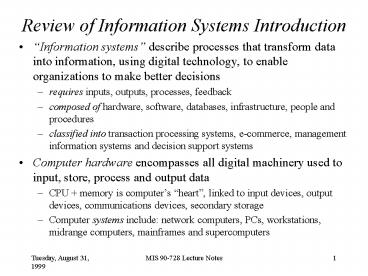Review of Information Systems Introduction - PowerPoint PPT Presentation
Title:
Review of Information Systems Introduction
Description:
Review of Information Systems Introduction Information systems describe processes that transform data into information, using digital technology, to enable ... – PowerPoint PPT presentation
Number of Views:125
Avg rating:3.0/5.0
Title: Review of Information Systems Introduction
1
Review of Information Systems Introduction
- Information systems describe processes that
transform data into information, using digital
technology, to enable organizations to make
better decisions - requires inputs, outputs, processes, feedback
- composed of hardware, software, databases,
infrastructure, people and procedures - classified into transaction processing systems,
e-commerce, management information systems and
decision support systems - Computer hardware encompasses all digital
machinery used to input, store, process and
output data - CPU memory is computers heart, linked to
input devices, output devices, communications
devices, secondary storage - Computer systems include network computers, PCs,
workstations, midrange computers, mainframes and
supercomputers
2
Information Systems Introduction (contd)
- Computer software encompasses all programs that
direct hardware to perform specific tasks - types include operating system, utility,
application software - application software purchase options include
proprietary, off-the-shelf and customized - application software scope includes personal,
workgroup and enterprise - applications are developed using languages
- software cost dominates organization IS total
costs - The Internet is a worldwide linkage of computers
that communicate - Every host sends, receives and transfers messages
and has a unique URL - Internet services include e-mail, FTP/telnet,
Usenet and telephony - The World Wide Web allows organized access to
documents anywhere on the Internet
3
Why Do We Focus on Relational Databases?
- Databases are the lifeblood of any organization
and answer the who/what/when/where/why of
operations. - Relational databases store large volumes of data
with a minimum of data duplication,
inconsistency, or anomalies, and encode key
business practices - Relational database management systems address
the collection, storage and management of data in
a relational databases, using - Tables
- Queries
- User interfaces
- Reports
- Application programs
Growth in Internet communications has increased
the importance of relational database design and
applications
4
Heinz School Network Information
- Computer information
- Nearly 100 computers in the clusters, nearly all
running Windows NT one Mac. - Nearly 100 more computers given to staff,
faculty, Ph.D students, etc. Staff and faculty
machines generally run Windows 95 Ph.D student
machines run Windows NT - Server information
- Five servers Sparc and NT servers for websites,
three-server setup for our Heinz domain
controllers (one primary, two backups). A few
stand-alone servers as well. - All servers will eventually run on Windows NT
Server. - Novell vs. NT
- Novell considered more robust, more stable and
less able to be hacked than Windows NT - Corporate purchasing decisions are dominating
technical considerations
5
The Wide World of Heinz
- The computing world at Heinz is divided into two
- The web server (domain www.heinz.cmu.edu) called
Howland a Sun Solaris machine running Unix - Howland is connected to the Andrew file system
- the PC world (domain HEINZ), in which three NT
servers connect all faculty, staff and student
computers, web/database/Exchange servers - HEINZ domain is part of the CMU meta-domain
CMU meta-domain
NT
Unix
http//www.andrew.cmu.edu
NT Server 1
http//www.heinz.cmu.edu
AFS
NT Server 3
NT Server 2
Communicate via FTP
Howland (Heinz School webserver)
Faculty, student, staff, servers
6
Overview of the Relational Database Model
- Relational databases can store any type of data
- IDs
- Codes
- Memos
- Numerical Values
- Hypertext Links
- Images/Sounds
- Date/Time
- Spatial attributes
- OLE
All organizations use these types of data in
their operations, but fewer use databases to
define relationships between data
7
Relational Database Example Service Delivery
- Aardvark Towing , Inc.
- Mission Tow vehicles from pick up sites to
destinations, charging by the mile towed. - Resources 5 trucks, 20 drivers, radio dispatch,
police scanners - Problems Need to automate records, beat out the
competition - Solution Database, change from random to
targeted truck locations
8
First Step in Relational Database Design
Identify Entity Sets
Entity Set Collection of similar persons,
things, places, events, concepts, or linkages
- Potential Entity Sets
- TRUCK
- DRIVER
- VEHICLE
- TOW
- VEHICLE DRIVER
9
Second Step Identify Primary Keys for Entity
Sets
- Primary Key Has a unique value for every entity
- Candidate Key Alternate primary key
10
Third Step Identify Attributes of Entity Sets
Attribute Characteristic or property of entities
11
Data Example tblTruck
12
Next Step Design Entity-Relationship Diagram
- An entity-relationship (E-R) diagram is a
blueprint of the relational database. It defines
associations between and within entities that
capture connectivity, cardinality, functional
relationship and others.
13
Relationships Between Tables - Example
tblTruck
tblTow
14
Last Step Full Relational Database Model
- tblTruck (Truck, Truck VIN, Truck Plate,
- Truck Make And Model Code, Truck
Year) - tblEmployee (Employee, Social Security Number,
First Name, - Last Name, Address,
Phone, DOB) - tblVehicle (Vehicle VIN, Driver_at_, Vehicle
Plate, - Vehicle State, Vehicle Make
and Model Code, - Vehicle Type, Vehicle Year,
Insurance Co.) - tblTow (Tow, Truck_at_, Employee_at_, Vehicle VIN_at_,
Date Towed, - Time Towed, Pick Up Address, Pick
Up Zone, - Destination Address, Distance Towed
(Miles), Comment) - tblVehicleDriver (Driver, First Name, Last Name,
Operator, - Street Address,
City, Zip Code, State, - Phone, Owner? )
15
What Else Is Needed to Create a RDBMS for
Aardvark Towing, Inc.?
- Build case for relational database management
system - Learn business rules, data sources
- Define and populate tables using a relational
database software - Implement E-R diagram relationships
- Build forms for data entry
- Display spatial data in GIS
- Implement spatial and aspatial queries
- Design summary reports
- Implementation and testing































